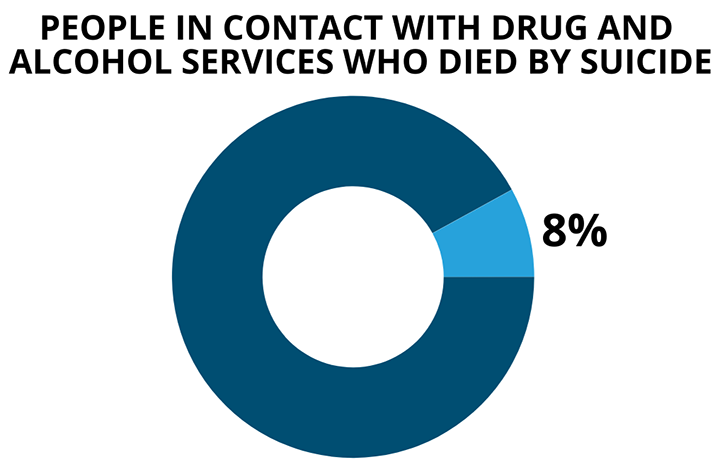
Suicide by people in contact with drug and alcohol services: a national study 2021 to 2022
Date of publication: February 2024
This report describes findings from a study linking national databases to examine the factors related to suicide by people under the care of drug and alcohol services. We linked mortality data on people who died by suicide (including probable suicide) to drug and alcohol treatment databases in England and Wales to establish the number of people who died by suicide within recent (12 month) contact with drug and alcohol services. We compared this group to people who had been in contact with drug and alcohol services in the previous year but did not die, to establish risk factors for suicide. We also collected data from serious incident reports into these deaths.
This report is based on deaths that were registered in a 12-month period between 1 October 2021 and 30 September 2022. It describes the clinical and psychosocial risk factors that may inform suicide prevention and makes recommendations for practice to improve safety for people under the care of drug and alcohol services.
Key messages
Contact with drug and alcohol services
Between October 2021 and September 2022, 428 people in England and Wales died by suicide within 12 months of contact with drug and alcohol services, 8% of all suicide deaths. The majority were men (80%); half (50%) were men aged 35-54 years.
Many (38%) of the people who died by suicide were under the care of these services at the time of their death, suggesting important opportunities for intervention.

Deprivation and socio-economic adversity
 Economic adversity was common in people who died by suicide within recent contact with drug and alcohol services. Almost half (47%) of people were unemployed, and most (81%) lived in social housing. Over a third (34%) lived in the 20% most deprived areas. This suggests suicide by people in contact with drug and alcohol services is often complicated by deprivation and socio-economic adversity.
Economic adversity was common in people who died by suicide within recent contact with drug and alcohol services. Almost half (47%) of people were unemployed, and most (81%) lived in social housing. Over a third (34%) lived in the 20% most deprived areas. This suggests suicide by people in contact with drug and alcohol services is often complicated by deprivation and socio-economic adversity.
We recommend frontline staff should have the information to signpost people to and encourage engagement with sources of financial support and advice.
Staff training
 We found in almost half (48%) of the people who died, the primary substance for which they were seeking help was alcohol. Overall, 40% of people who died by suicide had a record of more than one problem substance at the start of treatment.
We found in almost half (48%) of the people who died, the primary substance for which they were seeking help was alcohol. Overall, 40% of people who died by suicide had a record of more than one problem substance at the start of treatment.
Reducing excessive alcohol consumption and drug use for those under the care of services and at a population level is a key area for suicide prevention. We suggest training of staff in frontline agencies in assessment and management of alcohol and drug use is crucial.
Ongoing risk
 A quarter (25%) of people who died by suicide had completed treatment with drug and alcohol services prior to death and were reported as being substance free or an occasional user.
A quarter (25%) of people who died by suicide had completed treatment with drug and alcohol services prior to death and were reported as being substance free or an occasional user.
We suggest services need to be aware of ongoing risk even in those who appear well. We also recommend services should signpost people to voluntary services and provide reassurance that they can return to treatment if required.
Joint working with mental health services
 We found just under a third (30%) of people who died by suicide within recent contact with drug and alcohol services also had contact with mental health services in the previous 12 months. These people had high rates of self-harm (76%). A fifth (20%) had missed their last contact with mental health services, and 14% were not adherent with prescribed medication.
We found just under a third (30%) of people who died by suicide within recent contact with drug and alcohol services also had contact with mental health services in the previous 12 months. These people had high rates of self-harm (76%). A fifth (20%) had missed their last contact with mental health services, and 14% were not adherent with prescribed medication.
In line with national recommendations, we suggest mental health care for people who are using drugs and alcohol needs to be improved. We recommend that drug and alcohol services should work jointly with local mental health services to improve care, ensuring efforts are made to engage people with both mental health and substance use interventions where required.
Common factors associated with suicide
 Our examination of serious incident reports identified some important themes in a sample of people (n=100) who died by suicide within recent contact with drug and alcohol services. These were (1) socio-economic adversity, (2) interpersonal problems, (3) physical ill-health, (4) warning signals of recent self-harm and suicidal ideation/intent, and (5) recent contact with services, both drug and alcohol and mental health services.
Our examination of serious incident reports identified some important themes in a sample of people (n=100) who died by suicide within recent contact with drug and alcohol services. These were (1) socio-economic adversity, (2) interpersonal problems, (3) physical ill-health, (4) warning signals of recent self-harm and suicidal ideation/intent, and (5) recent contact with services, both drug and alcohol and mental health services.
Serious incident reports can contain useful information relevant to suicide prevention which is not available on routine databases. However, we found the reports varied in length and detail. We suggest that drug and alcohol services should consider assessing incident reports against available standards such as our NCISH 10 standards for investigating serious incidents.
Monitoring of trends
 Prior to this study the rate of suicide by people in contact with drug and alcohol services in England and Wales was unknown.
Prior to this study the rate of suicide by people in contact with drug and alcohol services in England and Wales was unknown.
We suggest there is scope for continuing linkage of mortality data and national drug and alcohol treatment data to monitor trends in suicide by people in contact with drug and alcohol services, identify antecedents, and inform suicide prevention initiatives.
